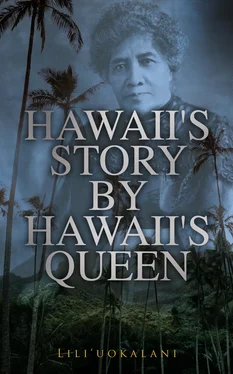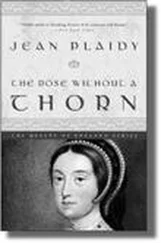But I was destined to grow up away from the house of my parents. Immediately after my birth I was wrapped in the finest soft tapa cloth, and taken to the house of another chief, by whom I was adopted. Konia, my foster-mother, was a granddaughter of Kamehameha I., and was married to Paki, also a high chief; their only daughter, Bernice Pauahi, afterwards Mrs. Charles R. Bishop, was therefore my foster-sister. In speaking of our relationship, I have adopted the term customarily used in the English language, but there was no such modification recognized in my native land. I knew no other father or mother than my foster-parents, no other sister than Bernice. I used to climb up on the knees of Paki, put my arms around his neck, kiss him, and he caressed me as a father would his child; while on the contrary, when I met my own parents, it was with perhaps more of interest, yet always with the demeanor I would have shown to any strangers who noticed me. My own father and mother had other children, ten in all, the most of them being adopted into other chiefs' families; and although I knew that these were my own brothers and sisters, yet we met throughout my younger life as though we had not known our common parentage. This was, and indeed is, in accordance with Hawaiian customs. It is not easy to explain its origin to those alien to our national life, but it seems perfectly natural to us. As intelligible a reason as can be given is that this alliance by adoption cemented the ties of friendship between the chiefs. It spread to the common people, and it has doubtless fostered a community of interest and harmony.
At the age of four years I was sent to what was then known as the Royal School, because its pupils were exclusively persons whose claims to the throne were acknowledged. It was founded and conducted by Mr. Amos S. Cooke, who was assisted by his wife. It was a boarding-school, the pupils being allowed to return to their homes during vacation time, as well as for an occasional Sunday during the term. The family life was made agreeable to us, and our instructors were especially particular to teach us the proper use of the English language; but when I recall the instances in which we were sent hungry to bed, it seems to me that they failed to remember that we were growing children. A thick slice of bread covered with molasses was usually the sole article of our supper, and we were sometimes ingenious, if not over honest, in our search for food: if we could beg something of the cook it was the easier way; but if not, anything eatable left within our reach was surely confiscated. As a last resort, we were not above searching the gardens for any esculent root or leaf, which (having inherited the art of igniting a fire from the friction of sticks), we could cook and consume without the knowledge of our preceptors.
I can remember now my emotions on entering this the first school I ever attended. I can recall that I was carried there on the shoulders of a tall, stout, very large woman, whose name was Kaikai (she was the sister of Governor Kanoa, and they were of a family of chiefs of inferior rank, living under the control and direction of the higher chiefs). As she put me down at the entrance of the schoolhouse, I shrank from its doors, with that immediate and strange dread of the unknown so common to childhood. Crying bitterly, I turned to my faithful attendant, clasping her with my arms and clinging closely to her neck. She tenderly expostulated with me; and as the children, moved by curiosity to meet the new-comer, crowded about me, I was soon attracted by their friendly faces, and was induced to go into the old courtyard with them. Then my fears began to vanish, and comforted and consoled, I soon found myself at home amongst my playmates.
Several of the pupils who were at the school with me have subsequently become known in Hawaiian history. There were four children of Kinau, daughter of Kamehameha I., the highest in rank of any of the women chiefs of her day; these were Moses, Lot (afterwards Kamehameha V.), Liholiho (afterwards Kamehameha IV.), and Victoria, of whom I shall soon speak. Next came Lunalilo, who followed Kamehameha V. as king. Then came Bernice Pauahi, who married Hon. Charles R. Bishop. Our family was represented by Kaliokalani, Kalakaua, and myself, two of the three destined to ascend the throne. Besides these I must mention Emma Rooke, who married one of the Kamehamehas, Peter Kaeo, Jane Loeau, Elizabeth Kaaniau, Abigail Maheha, Mary Paaina, and John Kinau Pitt; although these were all not there at the same time. Queen Emma, I remember, did not come in until after I had been at school some years.
We never failed to go to church in a procession every Sunday in charge of our teachers, Mr. and Mrs. Cooke, and occupied seats in the immediate vicinity of the pew where the king was seated. The custom was for a boy and girl to march side by side; the lead being taken by the eldest scholars. Moses and Jane had this distinction, next Lot and Bernice, then Liholiho with Abigail, followed by Lunalilo and Emma (after the later had joined the school), James and Elizabeth, David and Victoria, and so on, John Kinau and I being the last.
With the Princess Victoria, who died on the 29th of May, 1866, my younger life was connected in the following manner. When I was taken from my own parents and adopted by Paki and Konia, or about two months thereafter, a child was born to Kinau. That little babe was the Princess Victoria, two of whose brothers became sovereigns of the Hawaiian people. While the infant was at its mother's breast, Kinau always preferred to take me into her arms to nurse, and would hand her own child to the woman attendant who was there for that purpose. So she frequently declared in the presence of my adopted mother, Konia, that a bond of the closest friendship must always exist between her own baby girl and myself as aikane or foster-children of the same mother, and that all she had would also appertain to me just as if I had been her own child; and that although in the future I might be her child's rival, yet whatever would belong to Victoria should be mine. This insistence on the part of the mother was never forgotten; it remained in the history of Victoria's girlhood and mine until her death, although Kinau herself never lived to see her prophetic predictions fulfilled. Kinau died on the 4th of April, 1839, not long after the birth of her youngest child, Victoria.
On any occasion where the Princess Victoria was expected to be present I was always included in the invitation, so that whenever Kekauluohi, the sister of Kinau, invited her niece to be with her, I was also summoned to her residence. This aunt lived in a large stone house called Pohukaina, which stood not more than two hundred feet from the Royal School; and for our enjoyment she used to prepare all sorts of sweetmeats and delicacies peculiar to the Hawaiians, such as (to call them by our native names) kulolo , paipaiee , and koele-palau , with which our childish tastes were delighted.
In 1847 Moses left school, and went to reside with his father. In 1848 Jane Loeau married a Mr. Jasper. Abigail Maheha also left about the same time to reside with her aunt, the Princess Kekauonohi, and it was at this date that the epidemic of measles spread through the land; of those who fell victims to it were Moses Kekuaiwa, William Pitt Leleiohoku, who was a cousin of the Princess Kekauonohi and the first husband of the Princess Ruth (when later my younger brother was born, and adopted by Ruth, he took the name of her deceased husband); the third of these deaths in the families of the royal children was that of my little sister Kaiminaauao, who had been adopted by Kamehameha III. and his queen, Kalama.
This sad event made a great impression upon my younger days; for these relatives and companions of my youth died and were buried on the same day, the coffin of the last-named resting on that of the others. They were all buried in the royal mausoleum, which then was located where is now the yard of Iolani Palace. Since the erection of another building up the Nuuanu Valley, their remains have been removed with those of their ancestors.
Читать дальше












